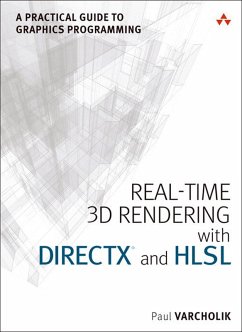Get Started Quickly with DirectX 3D Programming: No 3D Experience Needed This step-by-step text demystifies modern graphics programming so you can quickly start writing professional code with DirectX and HLSL. Expert graphics instructor Paul Varcholik starts with the basics: a tour of the Direct3D graphics pipeline, a 3D math primer, and an introduction to the best tools and support libraries. Next, you'll discover shader authoring with HLSL. You'll implement basic lighting models, including ambient lighting, diffuse lighting, and specular highlighting. You'll write shaders to support point lights, spotlights, environment mapping, fog, color blending, normal mapping, and more. Then you'll employ C++ and the Direct3D API to develop a robust, extensible rendering engine. You'll learn about virtual cameras, loading and rendering 3D models, mouse and keyboard input, and you'll create a flexible effect and material system to integrate your shaders. Finally, you'll extend your graphics knowledge with more advanced material, including post-processing techniques for color filtering, Gaussian blurring, bloom, and distortion mapping. You'll develop shaders for casting shadows, work with geometry and tessellation shaders, and implement a complete skeletal animation system for importing and rendering animated models. You don't need any experience with 3D graphics or the associated math: Everything's taught hands-on, and all graphics-specific code is fully explained. Coverage includes . The Direct3D API and graphics pipeline . A 3D math primer: vectors, matrices, coordinate systems, transformations, and the DirectX Math library . Free and low-cost tools for authoring, debugging, and profiling shaders . Extensive treatment of HLSL shader authoring . Development of a C++ rendering engine . Cameras, 3D models, materials, and lighting . Post-processing effects . Device input, component-based architecture, and software services . Shadow mapping, depth maps, and projective texture mapping . Skeletal animation . Geometry and tessellation shaders . Survey of rendering optimization, global illumination, compute shaders, deferred shading, and data-driven engine architecture
Dieser Download kann aus rechtlichen Gründen nur mit Rechnungsadresse in A, B, BG, CY, CZ, D, DK, EW, E, FIN, F, GR, HR, H, IRL, I, LT, L, LR, M, NL, PL, P, R, S, SLO, SK ausgeliefert werden.

